Looking for authentic Mexican pastries? What Is A Mexican Bakery Called? It’s a panadería, and gaymexico.net is your guide to discovering the most delicious and LGBTQ+-friendly spots in Mexico. We’ll explore these cultural gems, offering insights into their history, treats, and significance. Get ready to indulge in the sweet side of Mexico with pan dulce, traditional breads, and much more.
1. Unveiling the Sweet Secrets: What Is a Panadería?
A panadería is the Spanish word for bakery, a place where you can find a delightful assortment of breads, pastries, and cakes. In Mexico, panaderías are more than just bakeries; they are cultural institutions, often family-run, serving as community hubs where people gather to enjoy freshly baked goods. They are a staple of Mexican life, offering a wide variety of pan dulce (sweet bread) and other treats that reflect the country’s rich culinary heritage. These bakeries are especially welcoming in LGBTQ+ friendly destinations, making them a must-visit for any traveler.
1.1 The Heart of Mexican Baking
Panaderías are typically filled with the aroma of freshly baked bread and the vibrant colors of pan dulce. The shelves are laden with a tempting array of treats, from the iconic conchas to the flaky orejas. Each bakery has its own unique specialties and recipes, passed down through generations, ensuring that every visit is a new and exciting culinary adventure. These bakeries not only offer delicious treats but also preserve the cultural identity of Mexican communities.
1.2 A Sensory Experience
Stepping into a panadería is a sensory experience. The warm, inviting atmosphere, the sweet smells, and the visual feast of colorful pastries create a welcoming environment. The act of selecting your favorite treats with tongs and placing them on a tray is a ritual in itself. This communal experience is something that gaymexico.net celebrates, highlighting the inclusive and friendly nature of Mexican culture.
2. A Taste of Tradition: Exploring Popular Mexican Pastries
Mexican pastries, known as pan dulce, are a delightful blend of flavors, textures, and shapes. Influenced by Spanish and French baking traditions, Mexican bakers have added their own unique twist, incorporating native ingredients and techniques. Here are some of the most popular pan dulce that you’ll find in a panadería:
2.1 Concha: The Queen of Pan Dulce
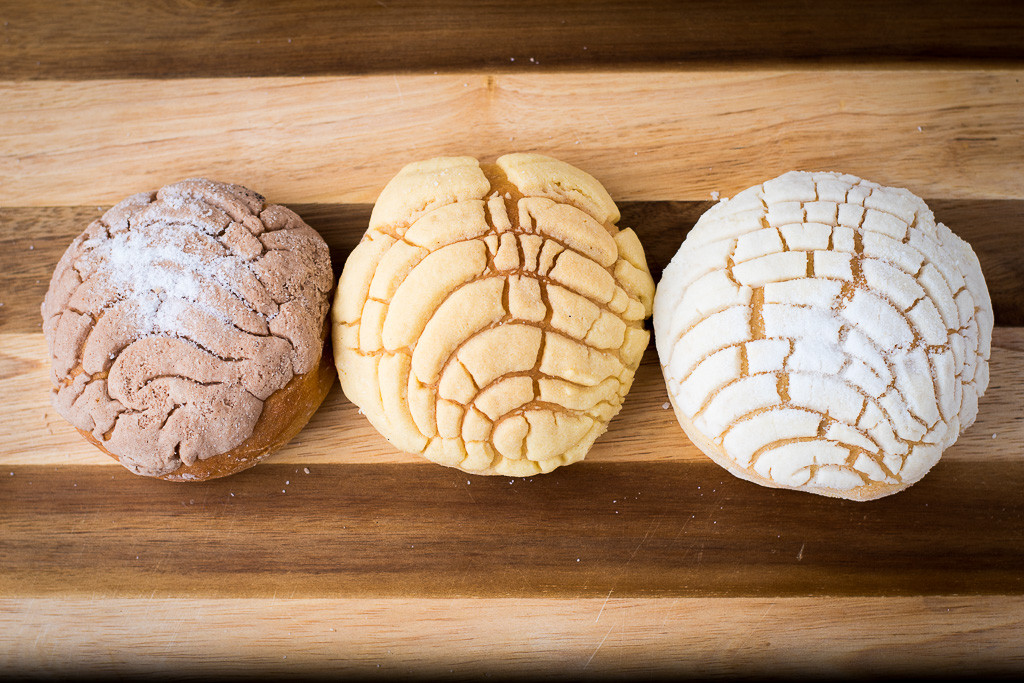 Concha/Pan de Huevo/Esponja at La Estrella Bakery Inc. (Credit: Jackie Tran)
Concha/Pan de Huevo/Esponja at La Estrella Bakery Inc. (Credit: Jackie Tran)
The concha, meaning “seashell” in Spanish, is perhaps the most recognizable and beloved pan dulce in Mexico. This sweet bread roll is topped with a sugary, shell-shaped crust, often flavored with vanilla or chocolate.
2.2 Oreja: The Elephant Ear
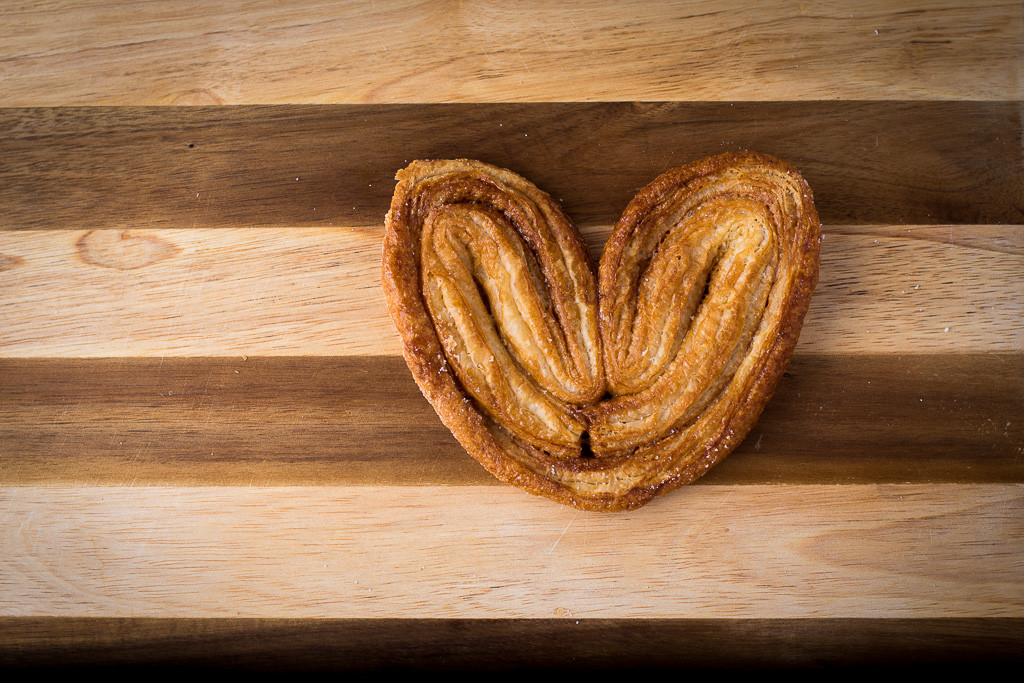 Oreja (elephant ear), a traditional flaky pastry resulting from French influence at La Estrella Bakery Inc. (Credit: Jackie Tran)
Oreja (elephant ear), a traditional flaky pastry resulting from French influence at La Estrella Bakery Inc. (Credit: Jackie Tran)
The oreja, meaning “ear,” is a flaky, crispy pastry similar to a French palmier. Its delicate layers and caramelized sugar coating make it a delightful treat to enjoy with coffee or milk.
2.3 Empanada: The Sweet Turnover
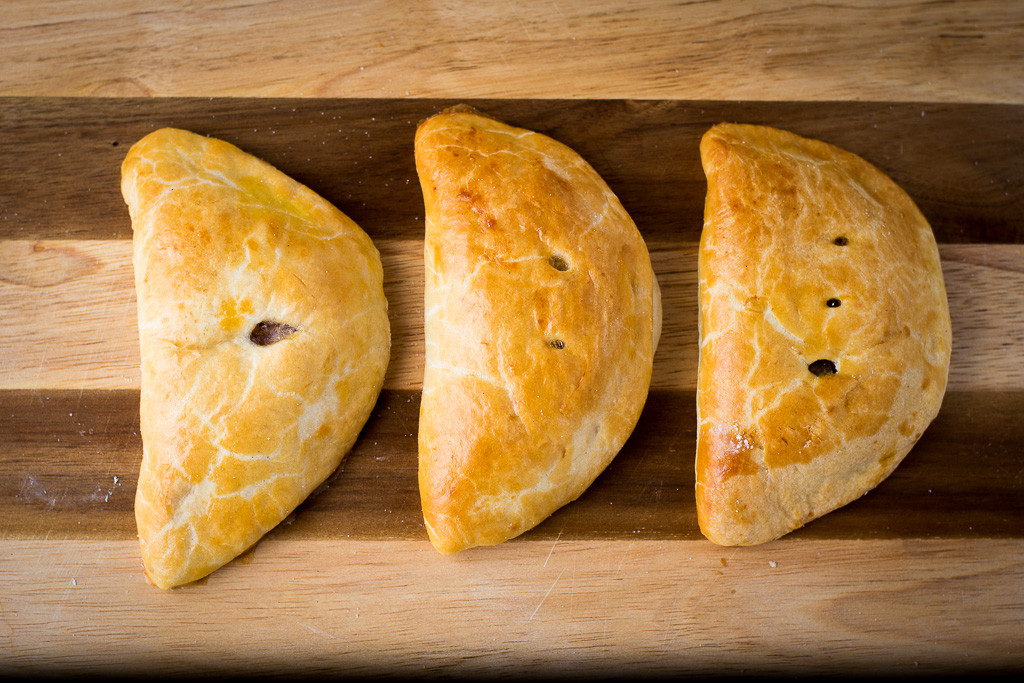 Empanadas, traditional soft fruit-filled turnovers at La Estrella Bakery Inc. (Credit: Jackie Tran)
Empanadas, traditional soft fruit-filled turnovers at La Estrella Bakery Inc. (Credit: Jackie Tran)
Empanadas are turnovers filled with sweet or savory ingredients. In panaderías, you’ll often find them filled with fruit fillings such as pineapple, apple, or pumpkin.
2.4 Coyota: The Cinnamon Delight
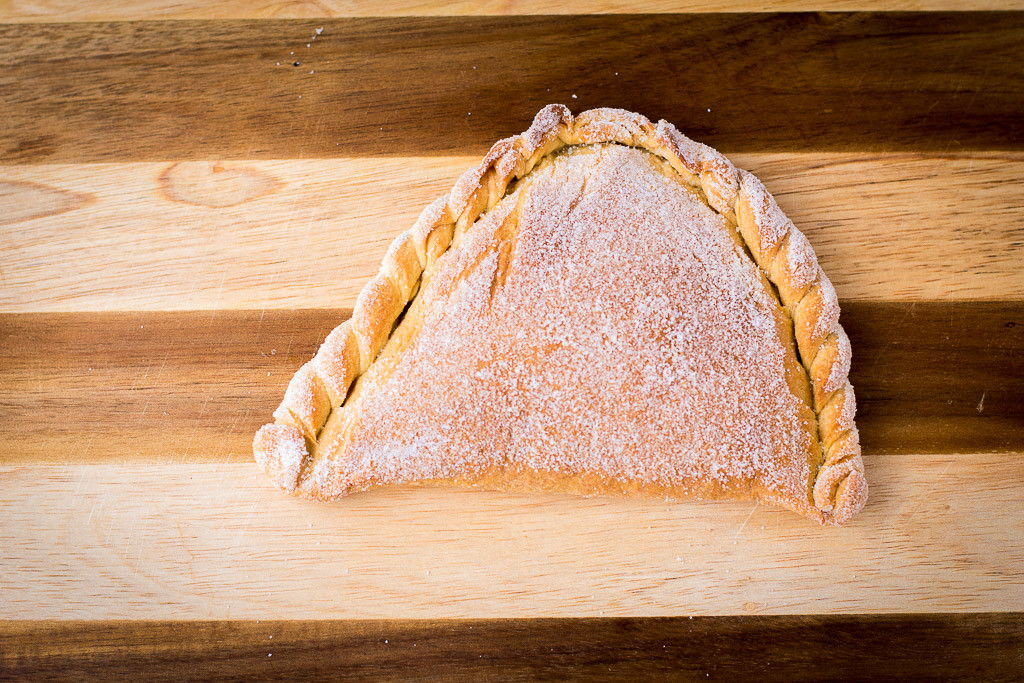 Coyota (cinnamon cookie filled with Mexican brown sugar) at La Estrella Bakery Inc. (Credit: Jackie Tran)
Coyota (cinnamon cookie filled with Mexican brown sugar) at La Estrella Bakery Inc. (Credit: Jackie Tran)
The coyota is a large, flat cookie filled with piloncillo, a type of unrefined cane sugar. Often flavored with cinnamon, it’s a sweet and satisfying treat with a slightly crunchy texture.
2.5 Cochito: The Little Pig
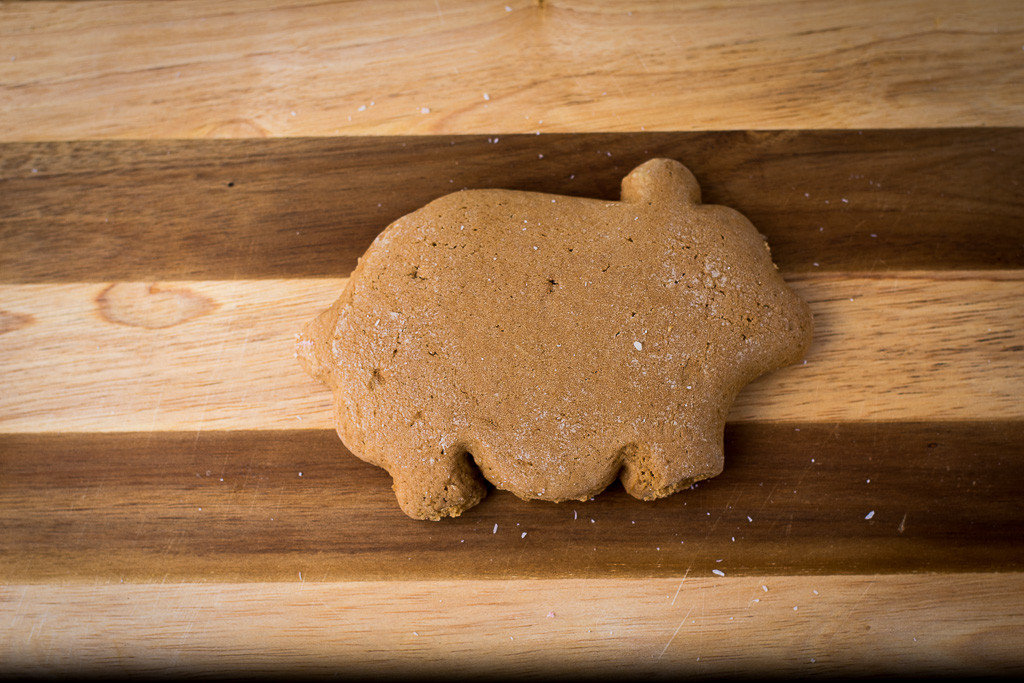 Cochito, a gingerbread cookie at La Estrella Bakery Inc. (Credit: Jackie Tran)
Cochito, a gingerbread cookie at La Estrella Bakery Inc. (Credit: Jackie Tran)
The cochito, meaning “little pig,” is a gingerbread-like cookie shaped like a pig. Despite its name, it doesn’t typically contain ginger, but rather molasses and cinnamon for a warm, comforting flavor.
2.6 Bandera: The Patriotic Cookie
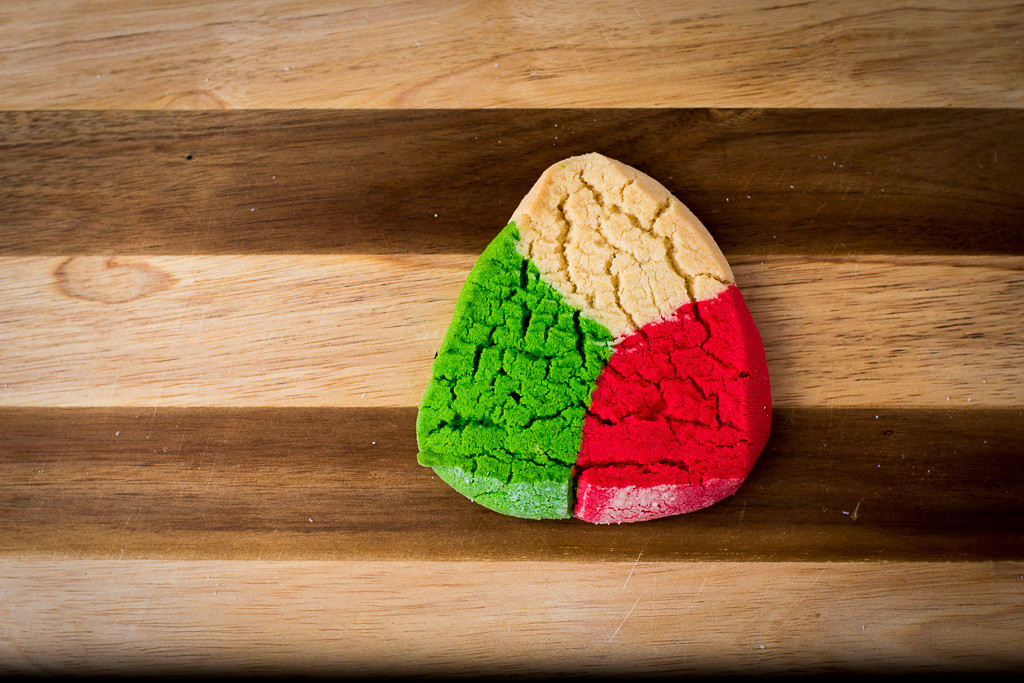 Bandera, a Mexican flag cookie at La Estrella Bakery Inc. (Credit: Jackie Tran)
Bandera, a Mexican flag cookie at La Estrella Bakery Inc. (Credit: Jackie Tran)
The bandera, meaning “flag,” is a tricolored cookie that represents the Mexican flag. Its sweet, buttery flavor and patriotic design make it a festive treat.
2.7 Chamuco: The Concha Cousin
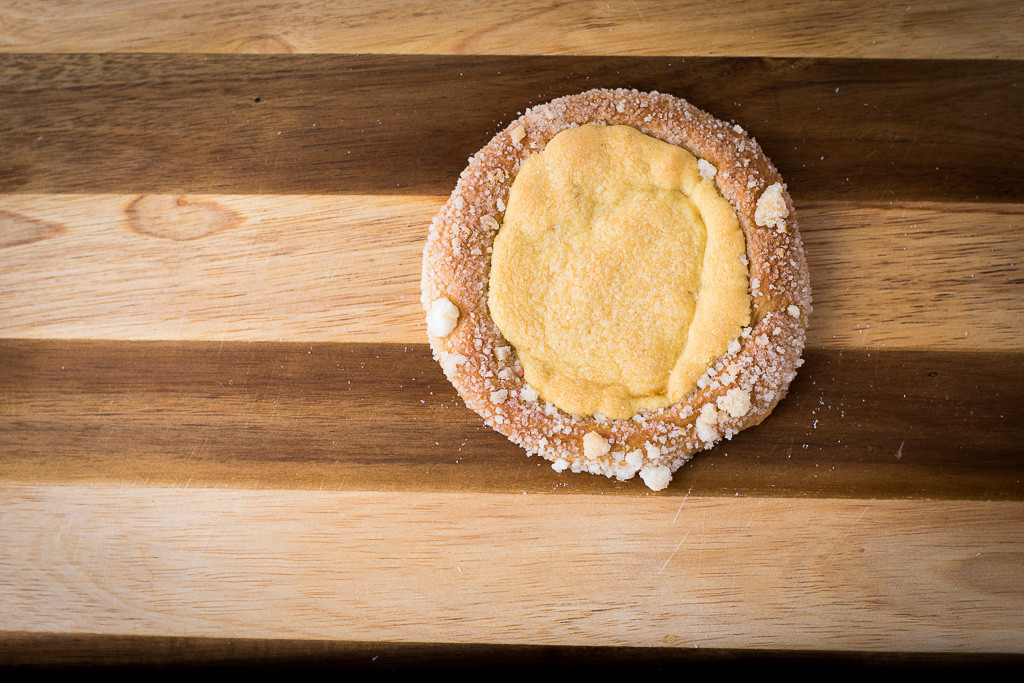 Chamuco, made with all Concha ingredients at La Estrella Bakery Inc. (Credit: Jackie Tran)
Chamuco, made with all Concha ingredients at La Estrella Bakery Inc. (Credit: Jackie Tran)
The chamuco is made with ingredients similar to the concha but has a flatter, more elongated shape. It’s often filled with cream cheese or fruit, adding a creamy, flavorful element to this pastry.
2.8 Galletas de Boda: The Wedding Cookies
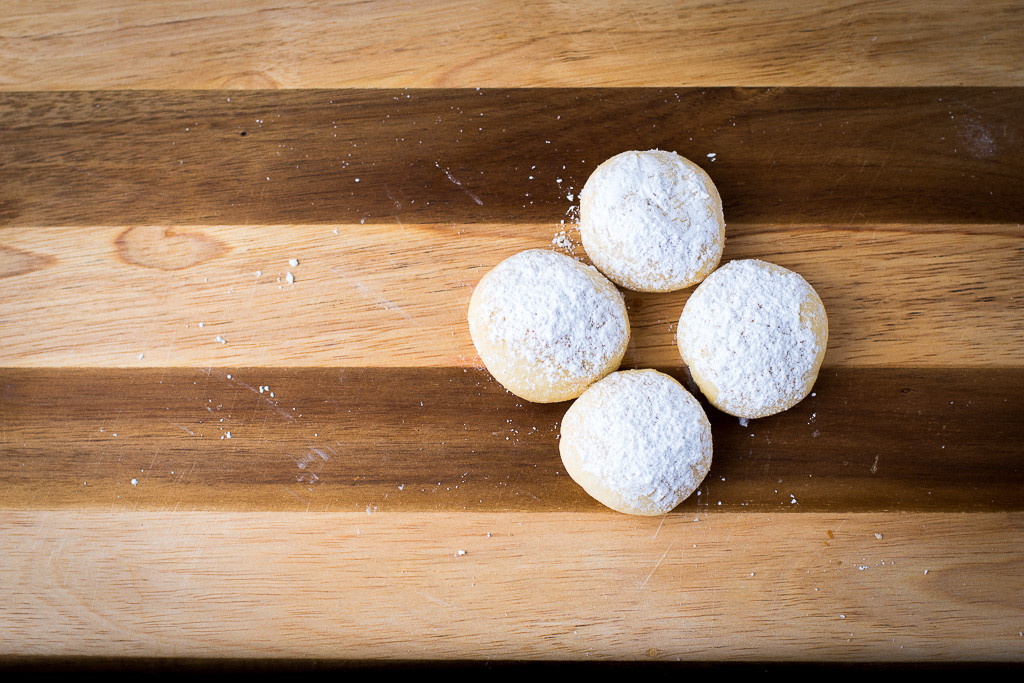 Galletas de Boda, Mexican wedding cookies at La Estrella Bakery Inc. (Credit: Jackie Tran)
Galletas de Boda, Mexican wedding cookies at La Estrella Bakery Inc. (Credit: Jackie Tran)
Galletas de Boda, meaning “wedding cookies,” are delicate, crumbly cookies coated in powdered sugar. They’re often served at weddings and other celebrations, symbolizing good luck and happiness.
2.9 Gallina: The Vanilla Cream Roll
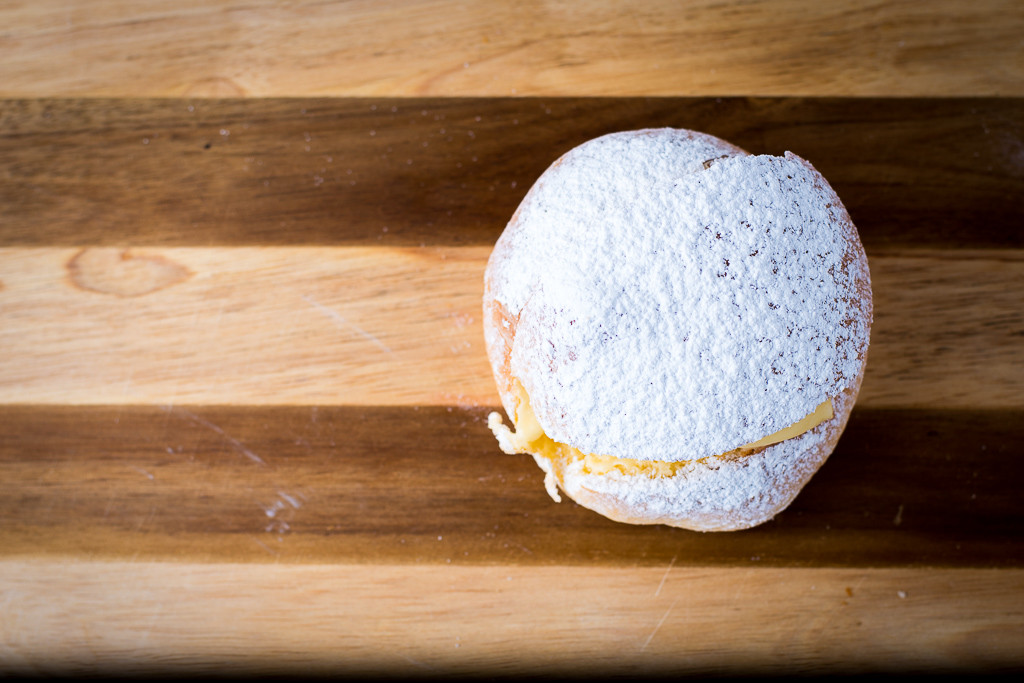 Gallina (chick),a traditional pan dulce roll filled with vanilla creme at La Estrella Bakery Inc. (Credit: Jackie Tran)
Gallina (chick),a traditional pan dulce roll filled with vanilla creme at La Estrella Bakery Inc. (Credit: Jackie Tran)
The gallina, meaning “hen” or “chick,” is a soft roll filled with vanilla cream. Its sweet filling and soft texture make it a comforting and satisfying treat.
2.10 Nino Envuelto: The Jelly Roll
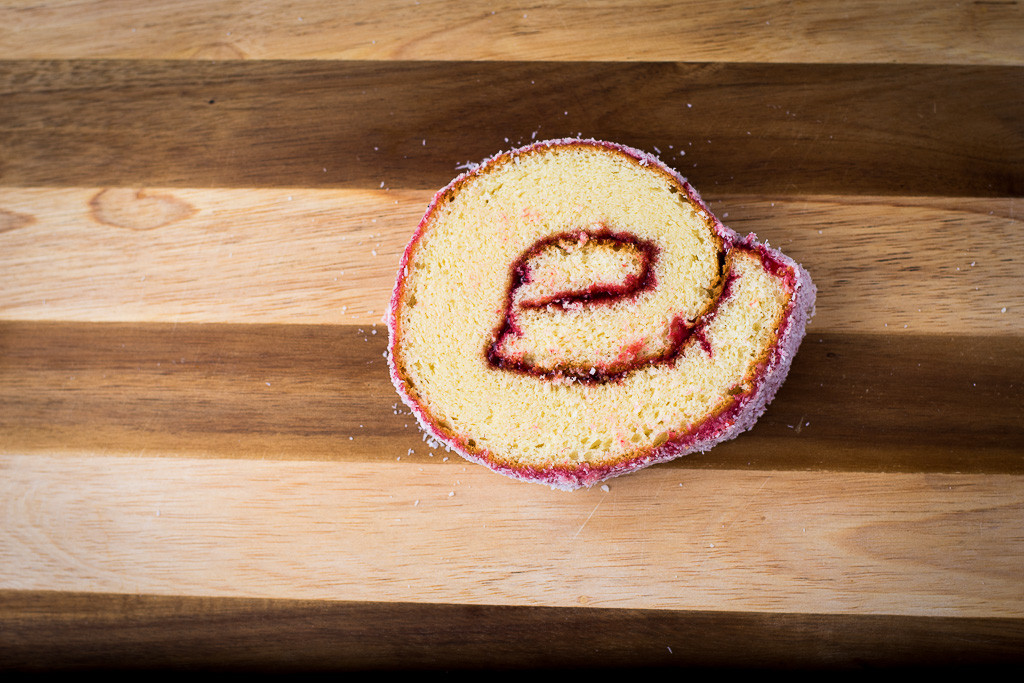 Cookie at La Estrella Bakery Inc. (Credit: Jackie Tran)
Cookie at La Estrella Bakery Inc. (Credit: Jackie Tran)
Nino Envuelto translates to “wrapped-up baby,” is a jelly roll. It is a soft and spongey cake with strawberry filling and tiny coconut shavings on the outside.
2.11 Pan Fino: The Artistic Breads
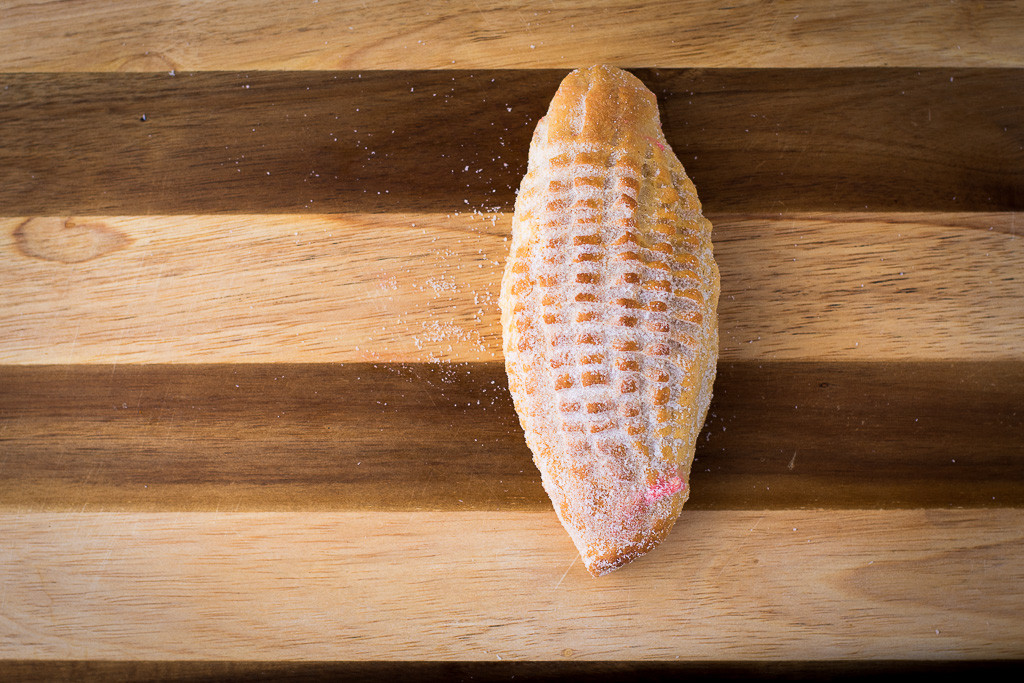 Pan Fino at La Estrella Bakery Inc. (Credit: Jackie Tran)
Pan Fino at La Estrella Bakery Inc. (Credit: Jackie Tran)
Pan Fino meaning “fine bread”, includes a series of pan dulce options. Every version of Pan Fino is shaped into a different design, each crafted by hand.
2.12 Yoyo: The Apple Sandwich
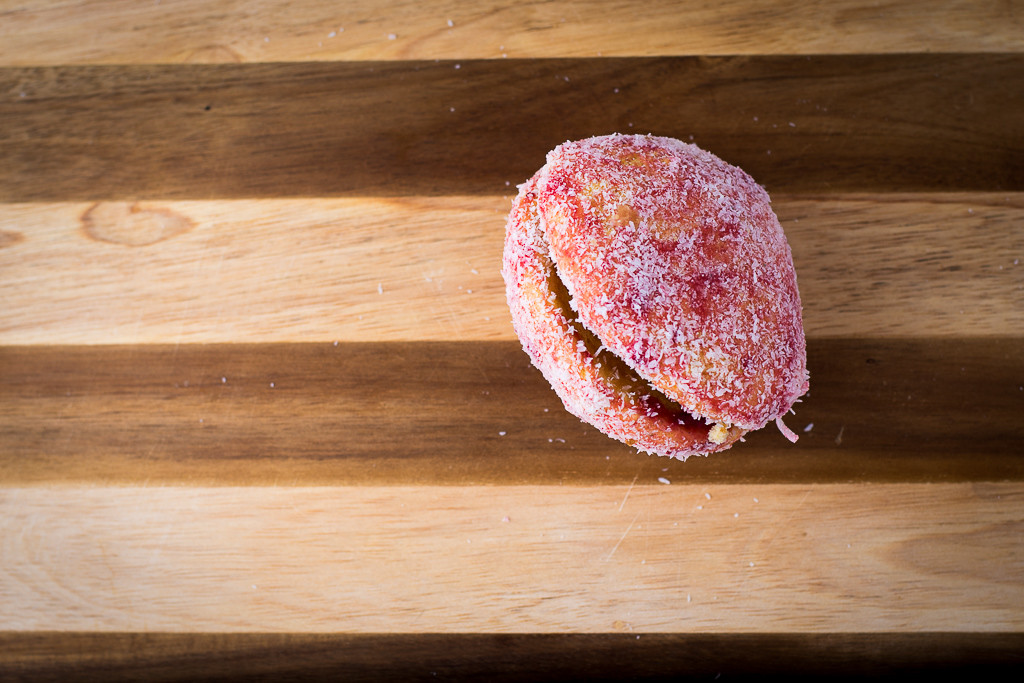 Yoyo/Ojo de Buey, two sweet breads with apple filling topped with strawberry jam and coconut at La Estrella Bakery Inc. (Credit: Jackie Tran)
Yoyo/Ojo de Buey, two sweet breads with apple filling topped with strawberry jam and coconut at La Estrella Bakery Inc. (Credit: Jackie Tran)
The yoyo is a sandwich of two sweet breads with apple filling in the middle. Because of the two rounded sweet breads, the pastry is said to look similar to a toy yo-yo.
3. The Sweet History of Mexican Panaderías and Pan Dulce
The history of Mexican panaderías and pan dulce is a fascinating blend of indigenous traditions, Spanish influence, and French techniques. This rich history has shaped the unique and diverse baking culture that exists in Mexico today.
3.1 The Spanish Influence
The arrival of the Spanish in the 16th century brought wheat and European baking techniques to Mexico. Wheat quickly became a staple in Mexican panaderías, although initially, it was more of a religious necessity for making sacramental bread.
3.2 The French Touch
The French introduced the art of bread-making to Mexico, with French bakers opening bakeries and introducing concepts such as baguettes, sweet pastries, and crispy rolls. The French influence is still evident in many Mexican pastries today.
3.3 A Mexican Evolution
While inspired by European traditions, Mexican panaderías and pan dulce have evolved to incorporate native fruits, flavors, and baking procedures. This has resulted in a unique and diverse range of pastries that reflect the country’s rich culinary heritage.
4. Finding the Best Panaderías in Mexico: A Gay Mexico Guide
Mexico is home to countless panaderías, each with its own unique charm and specialties. Whether you’re in a bustling city or a small town, you’re sure to find a panadería that will delight your taste buds. Here are some tips for finding the best panaderías in Mexico, with a focus on LGBTQ+-friendly destinations:
4.1 Puerto Vallarta: A Sweet Paradise
Puerto Vallarta, a popular LGBTQ+ destination, is known for its vibrant culinary scene, including its many panaderías. Stroll through the Romantic Zone and discover charming bakeries offering a wide variety of pan dulce and other treats.
4.2 Mexico City: A Culinary Capital
Mexico City, a cosmopolitan hub with a thriving LGBTQ+ community, boasts a diverse range of panaderías, from traditional family-run bakeries to modern artisanal shops. Explore neighborhoods like Roma and Condesa to find hidden gems.
4.3 Guadalajara: A Taste of Tradition
Guadalajara, known for its rich cultural heritage, is home to many traditional panaderías that have been serving the community for generations. Visit the historic center to discover these authentic bakeries and sample their delicious pan dulce.
4.4 Tijuana: A Border Town Treat
Tijuana, located on the border with the United States, offers a unique blend of Mexican and American influences. Its panaderías reflect this fusion, offering both traditional pan dulce and innovative creations.
4.5 Online Resources
Websites like gaymexico.net offer valuable resources for finding LGBTQ+-friendly businesses in Mexico, including panaderías. These resources provide information on location, reviews, and specialties, making it easier to discover the perfect bakery for your taste.
5. The Cultural Significance of Panaderías in Mexican Communities
Panaderías are more than just places to buy bread and pastries; they are integral parts of Mexican communities, serving as social hubs and cultural touchstones.
5.1 Gathering Places
Panaderías are often gathering places for families, friends, and neighbors. People come to share a cup of coffee, enjoy a sweet treat, and catch up on the latest news. The warm, inviting atmosphere of a panadería fosters a sense of community and belonging.
5.2 Preserving Traditions
Many panaderías are family-run businesses that have been passed down through generations. They preserve traditional recipes and baking techniques, ensuring that the cultural heritage of Mexican baking is kept alive.
5.3 Celebrating Special Occasions
Panaderías play a vital role in celebrating special occasions in Mexican communities. They provide the bread and pastries for weddings, birthdays, and holidays, adding a sweet touch to these important events. For example, Pan de Muerto is a special bread prepared for Dia de los Muertos celebrations.
6. Panaderías and the LGBTQ+ Community: A Welcoming Space
Mexican culture is known for its warmth and hospitality, and many panaderías embrace and celebrate the LGBTQ+ community. These bakeries offer a welcoming space for everyone to enjoy delicious treats and connect with others.
6.1 Inclusive Environments
In many LGBTQ+-friendly destinations in Mexico, panaderías are known for their inclusive environments. They welcome people of all backgrounds and identities, creating a safe and comfortable space for everyone to enjoy.
6.2 Supporting LGBTQ+ Businesses
By visiting and supporting panaderías in LGBTQ+-friendly areas, you can help to promote inclusivity and support local businesses that value diversity. Websites like gaymexico.net can help you identify these businesses and show your support.
6.3 A Taste of Home
For LGBTQ+ travelers, finding a panadería that feels welcoming can be a taste of home away from home. The familiar flavors and aromas of Mexican pastries can evoke feelings of comfort and nostalgia, creating a sense of connection to the culture.
7. Baking Your Own Pan Dulce: A Taste of Mexico at Home
If you can’t make it to Mexico just yet, you can still enjoy the flavors of pan dulce by baking your own at home. There are many recipes available online for classic Mexican pastries like conchas and empanadas.
7.1 Concha Recipe
 Concha/Pan de Huevo/Esponja at La Estrella Bakery Inc. (Credit: Jackie Tran)
Concha/Pan de Huevo/Esponja at La Estrella Bakery Inc. (Credit: Jackie Tran)
Ingredients:
- 4 cups all-purpose flour
- 1/2 cup granulated sugar
- 1 teaspoon salt
- 1 package (2 1/4 teaspoons) active dry yeast
- 1/2 cup warm milk
- 4 large eggs
- 1/2 cup unsalted butter, softened
Topping:
- 1 cup all-purpose flour
- 1 cup confectioners’ sugar
- 1/2 cup unsalted butter, softened
- 1 teaspoon vanilla extract
Instructions:
- In a large bowl, combine flour, sugar, salt, and yeast.
- Add warm milk, eggs, and butter. Mix until a dough forms.
- Knead the dough for 5-7 minutes until smooth and elastic.
- Place the dough in a greased bowl, cover, and let rise for 1-1.5 hours.
- While the dough rises, prepare the topping by combining flour, sugar, butter, and vanilla extract.
- Divide the dough into 12 equal pieces and shape them into balls.
- Flatten each ball slightly and top with the topping. Use a concha cutter or knife to create the shell pattern.
- Place the conchas on a baking sheet and let rise for 30 minutes.
- Preheat oven to 350°F (175°C) and bake for 15-20 minutes, or until golden brown.
7.2 Empanada Recipe
 Empanadas, traditional soft fruit-filled turnovers at La Estrella Bakery Inc. (Credit: Jackie Tran)
Empanadas, traditional soft fruit-filled turnovers at La Estrella Bakery Inc. (Credit: Jackie Tran)
Ingredients:
- 2 1/2 cups all-purpose flour
- 1 teaspoon salt
- 1 cup (2 sticks) unsalted butter, chilled and cubed
- 1/2 cup ice water
- 1 can (20 ounces) fruit filling (apple, pineapple, or pumpkin)
Instructions:
- In a large bowl, combine flour and salt.
- Cut in the chilled butter using a pastry blender or your fingers until the mixture resembles coarse crumbs.
- Gradually add ice water, mixing until a dough forms.
- Wrap the dough in plastic wrap and refrigerate for 30 minutes.
- Preheat oven to 375°F (190°C).
- On a lightly floured surface, roll out the dough and cut into circles.
- Place a spoonful of fruit filling in the center of each circle.
- Fold the dough over the filling to form a turnover and crimp the edges to seal.
- Place the empanadas on a baking sheet and bake for 20-25 minutes, or until golden brown.
8. Staying Safe and Informed: LGBTQ+ Travel in Mexico
While Mexico is known for its welcoming culture, it’s essential to stay informed and take precautions to ensure a safe and enjoyable trip for LGBTQ+ travelers.
8.1 Researching Destinations
Before you travel, research LGBTQ+-friendly destinations in Mexico. Cities like Puerto Vallarta, Mexico City, and Guadalajara are known for their vibrant LGBTQ+ communities and inclusive environments.
8.2 Staying Informed
Stay informed about local laws and customs related to LGBTQ+ rights. While Mexico has made progress in LGBTQ+ rights, attitudes and laws can vary depending on the region.
8.3 Connecting with the Community
Connect with local LGBTQ+ organizations and community groups. These organizations can provide valuable information and support, as well as opportunities to connect with other LGBTQ+ travelers and locals. Gaymexico.net offers a directory of LGBTQ+ resources in Mexico.
8.4 Exercising Caution
While most areas are safe and welcoming, it’s always a good idea to exercise caution and be aware of your surroundings. Avoid displaying public displays of affection in more conservative areas.
8.5 Reporting Incidents
If you experience any incidents of discrimination or harassment, report them to the appropriate authorities. You can also seek support from LGBTQ+ organizations and community groups.
9. Beyond Pan Dulce: Exploring Mexican Culinary Delights
While panaderías are a must-visit for their pan dulce, Mexico offers a wide range of culinary delights to explore. From savory street food to gourmet restaurants, there’s something for every palate.
9.1 Tacos: A Mexican Staple
Tacos are perhaps the most iconic Mexican dish, and for good reason. These versatile snacks can be filled with a variety of meats, vegetables, and sauces, offering a burst of flavor in every bite.
9.2 Tamales: A Traditional Treat
Tamales are a traditional Mexican dish made from masa (corn dough) filled with meat, cheese, or vegetables, and steamed in a corn husk. They’re often served during special occasions and holidays.
9.3 Mole: A Complex Sauce
Mole is a complex sauce made from a variety of ingredients, including chili peppers, chocolate, spices, and nuts. It’s often served with chicken or turkey and is a true culinary masterpiece.
9.4 Enchiladas: A Cheesy Delight
Enchiladas are corn tortillas filled with meat, cheese, or vegetables, and covered in a chili sauce. They’re often topped with cheese and sour cream for a cheesy, flavorful dish.
9.5 Street Food: A Culinary Adventure
Exploring Mexican street food is a culinary adventure in itself. From elotes (grilled corn on the cob) to churros (fried dough pastries), there’s a delicious treat to be found on every corner.
10. Frequently Asked Questions About Mexican Panaderías
Have more questions about Mexican panaderías? Here are some frequently asked questions to help you plan your visit:
10.1 What exactly does “pan dulce” mean?
“Pan dulce” simply means “sweet bread” in Spanish. It refers to the wide variety of sweet pastries and breads found in Mexican panaderías.
10.2 What are some must-try pan dulce items?
Some must-try pan dulce items include conchas, orejas, empanadas, coyotas, and cochitos. Each pastry offers a unique flavor and texture, so be sure to try a variety.
10.3 How much does pan dulce typically cost?
Pan dulce is typically very affordable, with most pastries costing between $0.50 and $2 USD. This makes it a budget-friendly treat for travelers.
10.4 Are panaderías LGBTQ+-friendly?
Many panaderías, especially in LGBTQ+-friendly destinations, are welcoming and inclusive environments. Look for businesses that are known for their diversity and support of the LGBTQ+ community.
10.5 Can I find gluten-free or vegan options at panaderías?
While traditional pan dulce is typically made with wheat flour and dairy products, some panaderías may offer gluten-free or vegan options. It’s best to inquire directly with the bakery to see what they have available.
10.6 What is the best time to visit a panadería?
The best time to visit a panadería is in the morning when the pastries are freshly baked. You’ll be greeted with the aroma of warm bread and a wide selection of treats to choose from.
10.7 Can I order pan dulce online?
Some panaderías may offer online ordering and shipping, especially if they are located in areas with large Mexican communities. Check the bakery’s website or social media pages to see if they offer this service.
10.8 Are there regional differences in pan dulce?
Yes, there are regional differences in pan dulce. Different regions of Mexico have their own unique specialties and variations on classic pastries. Be sure to try local specialties when you visit different areas.
10.9 What other products do panaderías offer besides pan dulce?
In addition to pan dulce, panaderías may offer other products such as bread, cakes, cookies, and savory pastries. They may also serve coffee, juice, and other beverages.
10.10 How can I find the best panaderías near me?
Websites like gaymexico.net can help you find the best panaderías near you, especially in LGBTQ+-friendly destinations. These resources provide information on location, reviews, and specialties.
Conclusion: Indulge in the Sweet Side of Mexico with Gaymexico.net
Exploring the panaderías of Mexico is a delicious and rewarding experience. From the iconic concha to the flaky oreja, there’s a sweet treat for every palate. And with gaymexico.net as your guide, you can discover the most LGBTQ+-friendly destinations and businesses in Mexico. So pack your bags, grab your sweet tooth, and get ready to indulge in the sweet side of Mexico!
Ready to explore the vibrant culture and delicious treats of Mexico? Visit gaymexico.net for comprehensive travel guides, LGBTQ+ friendly recommendations, and insider tips to make your trip unforgettable. Discover the best panaderías, cultural hotspots, and community events. Connect with us today and start your Mexican adventure!
Address: 3255 Wilshire Blvd, Los Angeles, CA 90010, United States.
Phone: +1 (213) 380-2177.
Website: gaymexico.net.